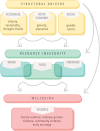Exploring resource scarcity and contextual influences on wellbeing among young refugees in Bidi Bidi refugee settlement, Uganda: findings from a qualitative study
- PMID: 33413546
- PMCID: PMC7790031
- DOI: 10.1186/s13031-020-00336-3
Exploring resource scarcity and contextual influences on wellbeing among young refugees in Bidi Bidi refugee settlement, Uganda: findings from a qualitative study
Abstract
Background: Contextual factors including poverty and inequitable gender norms harm refugee adolescent and youths' wellbeing. Our study focused on Bidi Bidi refugee settlement that hosts more than 230,000 of Uganda's 1.4 million refugees. We explored contextual factors associated with wellbeing among refugee adolescents and youth aged 16-24 in Bidi Bidi refugee settlement.
Methods: We conducted 6 focus groups (n = 3: women, n = 3: men) and 10 individual interviews with young refugees aged 16-24 living in Bidi Bidi. We used physical distancing practices in a private outdoor space. Focus groups and individual interviews explored socio-environmental factors associated with refugee youth wellbeing. Focus groups were digitally recorded, transcribed verbatim, and coded by two investigators using thematic analysis. Analysis was informed by a social contextual theoretical approach that considers the interplay between material (resource access), symbolic (cultural norms and values), and relational (social relationships) contextual factors that can enable or constrain health promotion.
Results: Participants included 58 youth (29 men; 29 women), mean age was 20.9 (range 16-24). Most participants (82.8%, n = 48) were from South Sudan and the remaining from the Democratic Republic of Congo (17.2% [n = 10]). Participant narratives revealed the complex interrelationships between material, symbolic and relational contexts that shaped wellbeing. Resource constraints of poverty, food insecurity, and unemployment (material contexts) produced stress and increased sexual and gender-based violence (SGBV) targeting adolescent girls and women. These economic insecurities exacerbated inequitable gender norms (symbolic contexts) to increase early marriage and transactional sex (relational context) among adolescent girls and young women. Gendered tasks such as collecting water and firewood also increased SGBV exposure among girls and young women, and this was exacerbated by deforestation. Participants reported negative community impacts (relational context) of COVID-19 that were associated with fear and panic, alongside increased social isolation due to business, school and church closures.
Conclusions: Resource scarcity produced pervasive stressors among refugee adolescents and youth. Findings signal the importance of gender transformative approaches to SGBV prevention that integrate attention to resource scarcity. These may be particularly relevant in the COVID-19 pandemic. Findings signal the importance of developing health enabling social contexts with and for refugee adolescents and youth.
Keywords: Adolescents; COVID-19; Food insecurity; Psychosocial stress; Refugee youth; Sexual and gender-based violence; Substance use; Uganda; Water insecurity.
Conflict of interest statement
Authors declare they have no competing interests.
Figures
Similar articles
-
Qualitative insights on sexual health counselling from refugee youth in Bidi Bidi Refugee Settlement, Uganda: Advancing contextual considerations for brief sexuality-related communication in a humanitarian setting.PLoS One. 2024 Nov 21;19(11):e0310682. doi: 10.1371/journal.pone.0310682. eCollection 2024. PLoS One. 2024. PMID: 39570903 Free PMC article.
-
Contextualizing HIV testing experiences within the HIV prevention cascade: qualitative insights from refugee youth in Bidi Bidi refugee settlement, Uganda.BMC Public Health. 2024 Sep 27;24(1):2599. doi: 10.1186/s12889-024-20135-2. BMC Public Health. 2024. PMID: 39334074 Free PMC article.
-
Exploring a syndemic of poverty, cumulative violence, and HIV vulnerability among refugee youth: multi-method insights from a humanitarian setting in Uganda.AIDS Care. 2024 Jan;36(1):36-43. doi: 10.1080/09540121.2023.2277151. Epub 2024 Jan 30. AIDS Care. 2024. PMID: 37921837
-
Exploring the State of Gender-Centered Health Research in the Context of Refugee Resettlement in Canada: A Scoping Review.Int J Environ Res Public Health. 2020 Oct 15;17(20):7511. doi: 10.3390/ijerph17207511. Int J Environ Res Public Health. 2020. PMID: 33076467 Free PMC article.
-
Health and Socio-Cultural Experiences of Refugee Women: An Integrative Review.J Immigr Minor Health. 2017 Aug;19(4):959-973. doi: 10.1007/s10903-016-0379-1. J Immigr Minor Health. 2017. PMID: 26976004 Review.
Cited by
-
Intersectional Stigma and Implementation of HIV Prevention and Treatment Services for Adolescents Living with and at Risk for HIV: Opportunities for Improvement in the HIV Continuum in Sub-Saharan Africa.AIDS Behav. 2023 May;27(Suppl 1):162-184. doi: 10.1007/s10461-022-03793-4. Epub 2022 Jul 30. AIDS Behav. 2023. PMID: 35907143 Free PMC article.
-
Symptoms of posttraumatic stress, anxiety, and depression, along with their associated factors, among Eritrean refugees in Dabat town, northwest Ethiopia, 2023.BMC Psychol. 2024 Feb 7;12(1):62. doi: 10.1186/s40359-024-01554-7. BMC Psychol. 2024. PMID: 38326883 Free PMC article.
-
Menstrual health among adolescents and young adults in rural Haiti.Reprod Health. 2022 Dec 20;19(1):227. doi: 10.1186/s12978-022-01533-4. Reprod Health. 2022. PMID: 36539795 Free PMC article.
-
Blockchain and Higher Education Diplomas.Eur J Investig Health Psychol Educ. 2021 Feb 19;11(1):154-167. doi: 10.3390/ejihpe11010013. Eur J Investig Health Psychol Educ. 2021. PMID: 34542456 Free PMC article. Review.
-
Social determinants of psychological distress in Sierra Leone.Soc Psychiatry Psychiatr Epidemiol. 2022 Sep;57(9):1781-1793. doi: 10.1007/s00127-022-02278-y. Epub 2022 Apr 19. Soc Psychiatry Psychiatr Epidemiol. 2022. PMID: 35441330 Free PMC article.
References
-
- Cronin AA, Shrestha D, Cornier N, Abdalla F, Ezard N, Aramburu C. A review of water and sanitation provision in refugee camps in association with selected health and nutrition indicators--the need for integrated service provision. J Water Health. 2008;6(1):1–13. doi: 10.2166/wh.2007.019. - DOI - PubMed
-
- Leddy AM, Weiser SD, Palar K, Seligman H. A conceptual model for understanding the rapid COVID-19–related increase in food insecurity and its impact on health and healthcare. Am J Clin Nutr. 2020:nqaa226 Available from: https://academic.oup.com/ajcn/advance-article/doi/10.1093/ajcn/nqaa226/5.... - DOI - PMC - PubMed
-
- FAO, IFAD, UNICEF, WFP, WHO . The State of Food Security and Nutrition in the World 2020: Transforming food systems for affordable healthy diets. Rome: FAO; 2020.
-
- Wutich A, Brewis A. Food, water, and scarcity: toward a broader anthropology of resource insecurity. Curr Anthropol. 2014;55(4):444–468. doi: 10.1086/677311. - DOI
Grants and funding
LinkOut - more resources
Full Text Sources
Other Literature Sources


